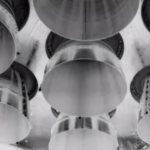This article originally appeared on JoeHoft.com and was republished with permission.
Guest post by Lynne Balzer
An article entitled “A Stratospheric Gamble” by Douglas Fox published in Scientific American on Oct. 1, 2023, describes the ongoing discussion and testing of the idea of shooting small particles of various chemicals into the stratosphere to reflect solar radiation, in the hopes of cooling the earth to combat global warming.
The article begins, “Global warming is so rampant that some scientists say we should begin altering the stratosphere to block incoming sunlight, even if it jeopardizes rain and crops.”
When Mount Pinatubo erupted in 1991, it ejected about 20 million tons of sulfur dioxide (SO2) into the atmosphere, slightly cooling the planet for a couple of years. Douglas Fox states that if sulfur dioxide were injected on a large enough scale – releasing perhaps one-fourth of that amount – one to two percent less sunlight would reach Earth’s surface.
Getting the sulfur dioxide high enough in the stratosphere to accomplish this goal is itself a challenge. No plane existing today can fly at that altitude, given the scarcity of molecules needed for lift. But scientists advocating for this operation believe that the B-47 Stratojet could possibly be modified within 7–10 years. To accomplish this task an entire fleet of these planes would have to be built. The projected cost of this operation is $18 billion per year for every degree of cooling produced. And this operation would have to be repeated every two years.
Although such an operation, dubbed Solar Radiation Management (SRM) would supposedly cost less than directly removing CO2 from the atmosphere, the article’s author claims that the fuel needed to send this fleet of planes that high could increase the entire expenditure of Earth’s energy as much as 25%. This seems highly unlikely. But it would take a lot of energy. And, of course, burning jet fuel produces carbon dioxide.
Strangely, these scientists may never have considered the fact that sulfur dioxide, reacting with water, produces sulfuric acid (H2SO4), which could remain in the atmosphere for as long as three years. This is acid rain! It was never mentioned in the article.
Another possibility that’s been suggested is to spray sea salt about 1000 meters high in order to seed clouds. Silver iodide could be used to seed cirrus clouds at an altitude of about 4500 – 9000 meters. Sarah Doherty, a climate scientist at the University of Washington, believes that a combination of methods used selectively would minimize possible risks.
This isn’t the first time that people have tried to influence climate. In 1962 a military project dubbed Storm Fury sprayed silver iodide particles into hurricanes in an effort to weaken them. During the Vietnam war Operation Popeye sprayed lead and powdered silver iodide into monsoon clouds to increase rainfall over the Ho Chi Minh trail, hoping to make it so muddy that the Vietcong would have a difficult time traversing it.
For decades studies using computer models have investigated the effect of various aerosols to determine which chemicals would be best to use and the ideal places to release them. The problem is that climate is very complicated, and climate science is still in its infancy. Not enough is known about the possible disruptions they might cause that could be far worse than any effect global warming has had.
One thing they’ve learned from these experiments is that the effects of playing with the climate are never local. They would have far-reaching consequences, such as shifting rainfall patterns that might cause flooding in one area and drought in another. A study conducted in South Africa concluded that such operations could even shift the prevalence of malaria from its current location in the highlands of east Africa to sub-Saharan Africa and southern Asia.
Dozens of variables must be considered. One of these is the rate at which these tiny droplets cause chemical reactions that destroy ozone. Some predict that if this operation is conducted, the currently blue sky would appear white. Others say SRM might cause more warming! Like a child playing with fire or opening Pandora’s box, these misguided efforts could disrupt the entire earth’s climate.
These studies have yielded conflicting results, but even those advocating for Solar Radiation Management have admitted that it could cause havoc.
Over 400 scientists signed an open letter recommending a ban on SRM. Katharine Ricke, Assistant Professor at Scripps Institution of Oceanography, characterized SRM as “a very dangerous place”.
But at the same time, 110 other scientists – including James Hansen, who initiated the global warming scare in the US in 1988 – wrote another open letter urging governments to go ahead with this plan. Kelly Wanser, director of Silver Lining, a nonprofit organization, is pushing for more testing to be financed by the National Science Foundation. But Alan Robock warns, “If somebody’s tempted to do this in the future, they should know what the consequences will be.
Perhaps we should first determine if there is a problem serious enough to warrant putting our earth’s climate in jeopardy.
Hundreds of fascinating facts about the climate change scam can be found in Lynne Balzer’s richly illustrated book, Exposing the Great Climate Change Lie, available on Amazon.
The post Engineering the Sky – The Great Climate Change Lie appeared first on The Gateway Pundit.







